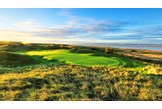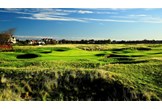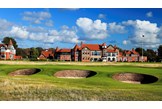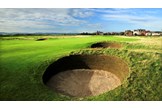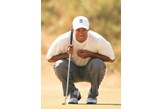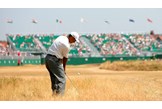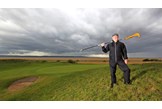Hoylake: How do you tame the beast?
Published: Last updated:
Who better to show us what it takes to win The Open at Hoylake than a caddie who’s spent his entire life there? With a little help from the man who tamed the course in 2006…
Your course guides
Tiger Woods: Staged one of the greatest exhibitions of course management in history when he plotted his way to victory in 2006, finishing on 16-under. Taking driver off the tee just once, he put on a long-iron ball-striking display unlike no other, kept his ball in position despite the dry, burnt out conditions that year.
Pat Lawton: Experienced caddie Pat grew up just a few miles from the course and has clocked up thousands of hours on the Hoylake links. He has been caddying for over 50 years, for both amateurs and Tour pros. He offers an unrivalled knowledge and understanding of the course and its greens.
Tiger Woods was still a decade away from being born when Pat Lawton began spending his days at Royal Liverpool Golf Club, more commonly known as Hoylake. His father had been a caddie there in the 1930s, using his local knowledge to earn himself a much-needed sixpence in the midst of the Great Depression, and a young Lawton saw that there was some pocket money to be made at his local links. From the age of 16 onwards, whenever he wasn’t playing the course, Lawton was caddying on it. He was pretty good at it, too, and got the nod when the European Tour came to town. “The first time I caddied for a pro was here in the 1981 European Open,” he says. “I caddied for Antonio Garrido – Ignacio’s father. He didn’t speak much English, but we managed to communicate. He made the cut.”
Lawton had the taste for professional caddying, and would later spend four years caddying for Italian pro Emanuel Canonica. “His best result during that time was in 2000, when he came second at the Deutsche Bank Championship in Hamburg” says Lawton. “Lee Westwood won; I think Ian Woosnam came third and Tiger Woods came fourth.”
Tiger may have come up short that day, but six years later, when The Open made its way to Hoylake for the first time in 39 years, he was the main man. Trailing by a shot after day one, he catapulted himself into the lead on the second day and remained there until the end. Here’s how they think this year’s tournament will be decided…
There are lots of makeable putts
“The greens aren’t particularly tricky,” says Lawton. “There are a couple of MacKenzie-style greens with split levels, where you need to make sure you’re on the right one or risk having a three-putt, but on the whole they’re not too challenging. There are little nuances here and there, but what you see is what you get.” Tiger isn’t as convinced that the greens are a walk in the park, especially if the pin positions are devilish. “Those were the most difficult pins I’ve ever seen at an Open,” he says. “With the flags the way they were, you’re going to have a bunch of 40 to 50-footers. A couple of times you feel like you hit a putt too hard, you’ll actually putt it right off the green. You never normally have that feeling at an Open, but it certainly was the case. My pace was really good all week, so I had a lot of kick-ins.”
It’s relatively short
The course will be 54 yards longer than it was when Tiger won in 2006 and, at 7,312 yards, will be the second-longest of the nine courses on The Open rota. You could therefore be forgiven for thinking Hoylake is all about length. You couldn’t be more wrong. It’s one of only two par-72 courses on the current rota, and actually plays as one of the shortest when you adjust the yardage to reflect the higher par. “It’s not a long course compared to other Open venues, because they’ve got nowhere to go,” says Lawton. “They can’t go that far back, simply because they haven’t got the space.”
Players who slogged their way round 7,562 yards at par-70 Pinehurst just a month earlier will certainly notice the difference in yardage. The longest par 5 at Hoylake is 577 yards, and normally plays downwind, while the longest par 5 at Pinehurst is 617 yards. The four par 3s at Hoylake average 188 yards, while the four at Pinehurst average 204 yards.
You might not need a driver
As a result, players might find the big stick spends more time sitting in the bag than launching balls off the tee. When Tiger won in 2006, he only hit driver once. He wasn’t familiar with the course, but a practice round was enough to tell him that driver wasn’t the go-to club.
“As I was playing the golf course, I would hit a couple of drives, and the driver would go 350-370 yards,” says Woods. “You can’t control that. The fairways are hard enough to hit as it is; you add driver and they go that far, now how hard is it to hit? I just felt if I stayed out of the bunkers the entire week and had just a decent week on the greens, I would be in contention on the back nine. You really have to control your ball in order to have a chance.”
“Hitting it straight is key,” says Lawton. “If you keep it in the right places, you can score very well, but as soon as you go off-line, you can get in real trouble. There’s internal out of bounds on several holes, which is unusual, and gorse areas that will penalise you heavily if you go near them.”
It’s all about the weather
“The only thing that protects this golf course is the weather,” says Lawton. “If it’s calm, dry and sunny like last time, they’ll annihilate it. I’m not saying we need rain – nobody wants rain – but if it’s windy, the players are really going to have to think hard about every shot. The course plays five or six shots different, depending on the weather, and the weather can change in minutes – if not seconds.” “The wind conditions kept changing,” agrees Tiger. “I never deviated from my overall game plan, but I had to adjust clubs off the tees.”
You can win it on the par 5s
With par 5s measuring 528, 532, 577 and 551 yards on the card, there are four birdie opportunities in every round. “If you just handle the par 5s, that’s 16-under par right there,” says Woods, who won with that total in 2006. “The closing three holes include two reachable par 5s,” says Lawton. “If you’re within a couple of shots of the lead, you can really make a big move, even at that late stage of proceedings.” The field averaged 4.46 shots per hole on the par 5s in 2006; if you walk off with a five, it feels like a bogey.
You can make moves on the back nine
All of the good scoring comes on the back nine. In 2006, the average score for the front nine was 0.2 shots over par. For the back nine, it was nearly a whole shot under. The front nine saw just 19 eagles across the whole week, a total matched by a single hole (the par-5 16th) on the back nine. The back nine saw more than twice as many eagles in total, and one and a half times as many birdies. There are more than twice as many bunkers (86) on the front nine than the back (41). The back nine features four of the five easiest holes on the course, according to the 2006 scoring. Ultimately, if you’re not setting the world alight at the turn, don’t panic: there’s still plenty of time to string together some red numbers and make up ground on the back nine.

